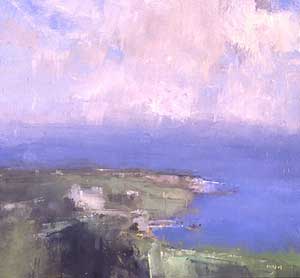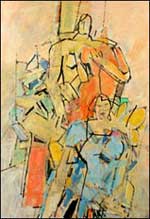
Gallery-Going Round-up
Alexi Worth and Jane Wilson at DC Moore Gallery; Charles Cajori at Lohin-Geduld Gallery; Stuart Shils at Tibor de Nagy Gallery; Group show at the Painting Center
by Maureen Mullarkey
ONCE UPON A DIME, I kept myself company with Dell comics. I copied frames from “Little Lulu,” filling notebooks with my own renditions of Irving Tripp’s artwork. But what keeps eleven year olds out of trouble can make problems for grown-ups.
Alexi Worth’s cartoon paintings and drawings at DC Moore invoke the knock-out panels of Jack Kirby, king of Marvel comics. Balding executives brawl like NBA fans at a Pistons game. Scenes are solidly drawn and elegantly “inked in” with flat oil colors. Mr. Worth creates attractive surfaces; he captures the graphic counterpoint of spare color harmonies and the madcap perspective of action comics.
His cartoon mannerism is deft and amusing. But something fizzles. The nub of it lies in the artist’s own self-interview, a faux-hip apologia that mirrors the tone of his work. Why are his characters middle-aged? Because “painting is a middle aged medium.” Too cute. Painting is ancient and perduring, something quite different. Why is conflict on his mind? Because an evenly divided electorate haunts him: “Indecisiveness is a kind of violence.” Gosh, no. In the 2004 election, both sides were firmly decided. One side won (POW! OOF!), and without violence to anything but the artist’s preferences. So why are these guys fighting? There’s no story, only posture.
The language of comics is a symbiosis of words and pictures, a fulcrum for narrative. Mr. Worth’s indifference to narrative seems a lapse of literacy by the standard of the strip cartoons he imitates. The vigor of comics lies in their story-telling legerdemain: the play between what is depicted and what disappears into gutters between frames. Here are only repetitive fragments, more reductive than their prototypes.
Mr. Worth has one eye on Roy Lichtenstein and another on Warhol, who appropriated Dick Tracy’s famous punch. A thunderclap in American newspaper comics 70 years ago, the slug of Chester Gould’s tough cop has lost its slam. Besides, Pop was yesterday. The jag is over and we have debts to pay. How long can we offer the carcass of the 60s and 70s as collateral?
Art does not have to be serious; it can just be fun or strike poses. But then it forfeits claim to the attention reserved for activities inhabiting a moral and intellectual dimension. Either we can make adult demands on art or we cannot. This work tries to have it both ways.




THE EMOTIONAL REGISTER RISES DRAMATICALLY in the work of Stuart Shils, an artist of great refinement. Current paintings at Tibor de Nagy were done in Ballycastle, on the wild northern coast of County Mayo, under the auspices of The Ballinglen Arts Foundation. He has painted there every summer for the last ten years, each time returning with a hauntingly beautiful body of work.
 |
| Stuart Shils, Gentle Morning, Drifting Sun, Toward the Stella Maris |
His landscapes dwell on the uncertain border between representation and abstraction; increasingly, they cross into pure suggestion. Landscape is inseparable from scenery; yet scenes all but dissolve, Turner-like, in these modestly scaled oils. In their place is something more elusive, harder to evoke: the mood of a locale and the temper of its weather. With each successive show, Mr. Shils reveals himself as a poet of atmosphere.
Paintings are small, never more than 12 by 14 inches. In part, the size accommodates the demands of travel. At the same time, it is absolutely right for the intimacy of Mr. Shils’ response to fugitive conditions of light and mist. As he admits: “In a moment it’s all over anyway because the clouds are moving like stage sets in front of the sun and now it’s gone flat.”
Drenched in fogs surging in from the North Atlantic, Mayo is kissed by a cool Artic light so distinctive that it has its own name: the Blue Charm. Mr. Shils pays homage to that light, refracted through moisture and seized with plein air veracity. His titles have the ring of notes to himself jotted down on site. A literary touch, they confirm the sense of sheer immediacy passionately conveyed by each work.
“Gentle Morning, Drifting Sun, Toward the Stella Maris” (2004), a radiant panorama of Bunatrahir Bay from the high coastal road, comes closest to description. Yet even here, no definitive contours slow the movement of the painting. The Stella Maris, once a fortress, is a blurred rectangle of subdued white cresting an expanse of modulated greens and cobalts that evaporate into cloud. Truth to nature is in his color; delineation is needless.
The simplicity of his painting belies the mastery that permits Mr. Shils the freedom of his responses and insures the luminous delicacy of his results.




NATURE KEEPS ITS HEAD DOWN in “Nature Abstracted,” a group exhibition curated by Emily Berger . The natural world is invoked rhetorically but largely abandoned on canvas. Emphasis is on the thing least helpful in the quest for form: that old deceiver, the artist’s “inner world”.
But no matter. Any excuse is welcome to see Farrell Brickhouse’s small gouaches, astonishing in their transparency. Optical complexity and punch is greater here than in his recent larger oils. The kinetic illusion of Margaret Neill’s dynamic ovoid planes keep growing richer, more painterly. And Julian Jackson’s moody color and silken surfaces, like reflecting pools lit from within, left me wanting to see more. Lois Ellison’s “Table Grave” (2000), a small oil of singular, uncluttered charm, illustrates the autonomous satisfactions of tone and proportion.
“Alexi Worth: Only Connect” at DC Moore Gallery (724 Fifth Avenue, 212-247-2111). “Stuart Shils: Chasing the Sky” at Tibor de Nagy (724 Fifth Avenue, 212-262-5050.). “Nature Abstracted” at The Painting Center (52 Greene Street, 212-343-1060).




BY THE LATE 50S, WORD WAS OUT that the figure was dead, no longer a viable subject for art Three young painters in the Bay Area ignored the obits: Richard Diebenkorn, Elmer Bischoff and Charles Cajori. They met weekly in Bischoff’s studio to draw from live models, defying fashionable dogma by applying painterly intelligence to a form more durable than any -ism in the arts.
 |
| Cajori, Untitled 2004 |
That initial shared sympathy with the human figure has shaped Mr. Cajori’s paining over the decades. A second generation Abstract Expressionist and one of the founders of New York’s legendary Tanager Gallery, he has enlivened the conventions of abstraction with steady reference to the figure. He is not interested in personality or individuating features. Rather, it is the interaction of the figure with the space around it that is the lynch pin of his picture-making.
All but one of the 15 paintings on view are untitled, a cue not to seek anecdote or sentiment within the compositions. In each, fractured and faceted female figures and the unspecified spaces they inhabit jockey for position on the canvas like shifting tectonic plates. The larger paintings in the front room are particularly vivacious examples of what Mr. Cajori calls as “the war between space and figure.”
His pleasure in the act of painting is visible in dynamic surfaces built from successive waves of substantial but still- transparent oil washes. Movement is everywhere, inviting the eye to follow color reefs that advance and recede in continuous, contained upheaval. There is a controlled electricity to his color, muted by pentimenti and held in check by fluid scrubbings of warm neutral tints
I knew Charles Cajori’s name before I knew his work. Some years ago, wandering the Mattatuck Museum in Waterbury, Connecticut, I caught sight of an imposing, luminous abstraction across a room. I hurried to read the tag. So this was Cajori! In that moment I understood why his name kept surfacing, a persistent thread in discussions of abstract painting. Be glad that his painting is now readily visible in New York. This show is a satisfying and welcome event.




JANE WILSON NEEDS NO INTRODUCTION. She is a seductive painter whose pictorial protocol is restrained and unchanging: a low-horizoned, simplified landscape schema that tethers an abstract sensibility to the natural world. It is an evocative formula, evading naturalism while summoning assent to the seeming naturalness of dramatic expanses of sky and conjured weather conditions.
Her approach has remained constant; yet it never appears twice-told or mechanical. Absence of structural variation makes the diversity of these skyscapes all the more remarkable. Lesser painters succumb eventually to their own conventions. Ms. Wilson, on the contrary, continues to refresh a single dominating idea, offering it anew with each exhibition.
Anchored to reality, her work is vivified by the natural kaleidoscope of cloud formations and their gestural drift. Paint handling is deft; but it is Ms. Wilson’s gift for color and light that is most alluring. She is an inspired colorist, evoking what Constable termed “the chiaroscuro of nature” with intense, invented color harmonies. The orange-gold cloudbank of “More Clouds Than Sun” (2004) is audacious and fanciful.The cirrocumulus cloudlets of ”Red Sky at Night” (2004) blanket a horizon that is more felt than seen. Here is the pleasure of color field painting rescued from its rejection of the world.




“Charles Cajori” at Lohin-Geduld Gallery, 531 West 25 Street, Tel. 212.675.2656.“Jane Wilson” at DC Moore Gallery, 724 Fifth Avenue, Tel. 212.247.2111.
These reviews were first published in The New York Sun, Thusday, December 9, 2004 and Friday, November 26, 2004, respectively.
Copyright 2004 Maureen Mullarkey







